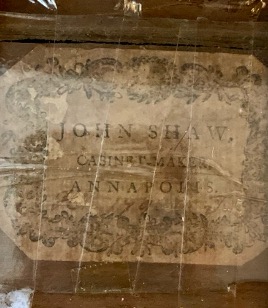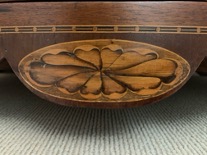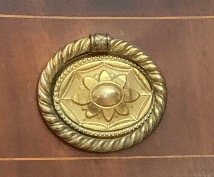A Treasure(d) Chest of Drawers at Historic Annapolis
- HistoricAnnapolis

- Apr 25
- 4 min read
Happy Birthday to John Shaw!

My name is Elizabeth Fox, and I’m pleased to introduce myself as the Curator at Historic Annapolis (HA). It’s been an incredibly busy yet wonderful year or so since my arrival in June 2024. Each day brings something fresh and exciting, allowing me to wear different hats—one day I’m cleaning and dusting objects, and the next day I’m installing exhibits!
As someone who manages HA’s entire collection, I receive numerous messages from people looking to donate their objects to us. There is a vetting process in which we accept items based on the following prerequisites: they must relate to HA’s mission and scope of collecting; possess a firm provenance (or previous ownership history); connect to Annapolis and/or Maryland history; fit the period of interpretation for one of HA’s historic sites; appear to be of good quality; and is considered suitable for display or can be preserved in storage. If I determine the item is worth adding to the collection, I propose it to our Collections Committee who recommends it to the Board. After a majority vote, it is officially accessioned as a collection object.

One of the first acquisitions I oversaw for HA occurred during the summer of 2024. We received as a bequest an exceptional chest of drawers made in 1793 by the local and highly renowned cabinetmaker, John Shaw (1745-1829). Born in Glasgow, Scotland on April 25, 1745 (today is his 280th birthday!), Shaw arrived to Annapolis in 1763 as a trained craftsman and architect. Among his many achievements, he received contracts to help build the Maryland State House and its entire suite of furniture inside the Senate chambers. He also led an active career as undertaker of the State House, importer of goods, and Armorer of the state militia in 1777. His partner Archibald Chisolm (c. 1740-1810), also from Scotland, worked with him briefly between 1772 and 1776. Together, they constructed the case for a tall case clock assembled by Annapolis silversmith and clockmaker William Faris (1728-1804), located in the dining room of the William Paca House & Garden. With the help of his shop, Shaw brought the taste for Neoclassical design to Annapolis’ private homes and public buildings.

Visitors of Annapolis can observe examples of Shaw furniture at the Maryland State House, Hammond-Harwood House, and William Paca House. Yet HA’s newest acquisition, with its brass bail handles, stands out from the rest for several reasons. Furniture historian William Voss Elder III and Lu Bartlett claim this chest is atypical of John Shaw's work in that it is one of four known pieces—a sideboard and three card tables—that adopts the serpentine form [1]. This was likely taken from a design plate illustrated in George Hepplewhite's The Cabinet-Maker and Upholsterer's Guide (1788 edition).
Shaw favored a more conservative style of furniture with clean lines and elegant restraint, making this piece all the more unusual. However, features of this piece that point us to Shaw include the use of string inlay and oval paterae [2] in the bottom center scallop of the skirt. Additionally, inside the top drawer is a paper label that reads “John Shaw, Cabinetmaker, Annapolis” with the initials “H T;” the latter may refer to an unidentified apprentice or journeyman working for Shaw. Other labels in Shaw furniture from circa 1790 also contain initials in similar script. For instance, Elder and Bartlett speculate that the “W T” initials inside a cellarette may stand for William Tuck, who was considered responsible for producing many of Shaw’s pieces [3]. Whether and how “H T” is personally or professionally connected to Tuck and Shaw remains a mystery to be solved.
Furthermore, the John Shaw chest of drawers has a detailed provenance that likely connects it to Maryland’s signer of the Declaration, William Paca (1740-1799). According to family tradition, the chest originally belonged to Paca, with a long line of descendants owning this piece after him. As ardent patriots during the Revolutionary War, Shaw and Paca would have often interacted and conducted business with one another. It was in 1783 that Governor Paca commissioned Shaw to create two United States flags to hang over the State House and Governor’s Mansion, in preparation for the arrival of Congress in Annapolis. However, I have yet to find primary source documentation linking this piece to Paca. The burning of Paca’s residence at Wye Hall in 1879 destroyed important family papers, including what would have been his major account books. If William Paca indeed owned this piece, he may have placed it among his other Federal-style furnishings in his coastal Queenstown mansion, Wye Hall. A bedstead in HA’s collection also has a strong Paca provenance from when he and his family moved out of his Prince George Street home in 1780. Both items are now displayed together in the hall bedchamber (or “room at rest”) at the William Paca House. As a man of means during and after the Age of Elegance in Annapolis, Paca would have purchased furniture pieces made of exotic woods like mahogany. The process of harvesting and transporting mahogany from the Caribbean or South America cost the lives of enslaved African laborers. The demand for non-European woods also led to deforestation, so much so that by the late 18th century, pure mahogany became a scarce commodity. An unfortunate and hidden legacy of the luxury transatlantic trade that is today reflected in surviving furniture pieces like HA’s chest of drawers.
Research is still ongoing, but I cannot wait to see what else can be discovered from digging into this piece. In the meantime, see this chest of drawers for yourself when you visit the William Paca House & Garden!
-Contributed by Elizabeth Fox, Historic Annapolis Curator
#HistoricAnnapolis #Annapolis #AnnapolisHistory #JohnShaw #chestofdrawers #furniture #ArchibaldChisholm #AmericanRevolution #Neoclassicism #MarylandStateHouse #HammondHarwoodHouse #WilliamPacaHouse #WyeHall #WilliamTuck #GeorgeHeppelewhite #inlay #paterae #mahogany #luxury #AgeofElegance
[1] William Voss Elder III and Lu Bartlett, John Shaw: Cabinetmaker of Annapolis (Baltimore: The Baltimore Museum of Art, 1983), p. 96, no. 27. In 1980, the Baltimore Museum of Art hosted its exhibition “John Shaw: Cabinetmaker of Annapolis,” which featured our chest.
[2] Paterae are ornamental and elliptical bas-relief discs, resembling a shallow dish, that embellished ancient Roman friezes and walls. This decorative element can be seen in 18th-century western architecture that was primarily influenced by Italian Renaissance architect Andrea Palladio.
[3] Elder and Bartlett, p. 102, no. 32. See also Alexander Lourie, “‘To Superintend the Necessary Repairs”: The Careers and Work of William and Washington Tuck,” American Furniture, ed. Luke Beckerdite (Milwaukee: Chipstone Foundation, 2006).












Comments